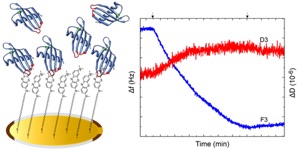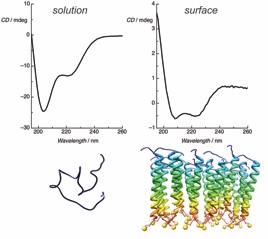
``
Bio-Inspired Technologies
Immobilization of biomolecules on-surface
The immobilization of biological molecules onto inorganic surfaces is critical to many biophysical analytical techniques and underpins a wide range of emerging technologies from in vitro diagnostics and tissue engineering to directed self-assembly and biomolecular electronics. We are undertaking a range of fundamental studies aimed at developing novel approaches for immobilizing functional biomolecules onto planar surfaces and understanding the inter-molecular interactions that occur in high-density two-dimensional molecular monolayers.
For more information see our list of publications or email steven.johnson@york.ac.uk
Recent highlights
Peptide monolayers
We have used on-surface circular dichroism to investigate the conformation of surface-immobilized peptides. In solution, our peptide adopts a random coil conformation. However, once immobilized we found that α-helical secondary structure can be induced and stabilized by inter-molecular interactions within the highly packed peptide monolayer. Our findings not only provide insight into molecular crowding effects that are known to be critical in high molecular density environments, such as within the cell, but also highlights the potential role that molecular crowding can play in many current and emerging technologies involving surface-immobilized biomolecular systems.
Small molecule immobilisation
Recent advances in protein engineering have led to the emergence of antibody mimetics that offer the high affinity and specificity associated with antibodies, but with in vitro selection to ensure rapid discovery of binders against a wide range of targets. We have shown that Affimers, a recent example of antibody mimetics, are suitable bioreceptors for the detection of small organic target compounds, here methylene blue. Target immobilization for Affimer selection and characterization was achieved using long-chained alkanethiol linkers coupled with oligoethylene glycol. Critically, we showed that the Affimer displayed an affinity constant comparable and high selectivity for its target, even in complex sample matrix, here a limnetic sample.





